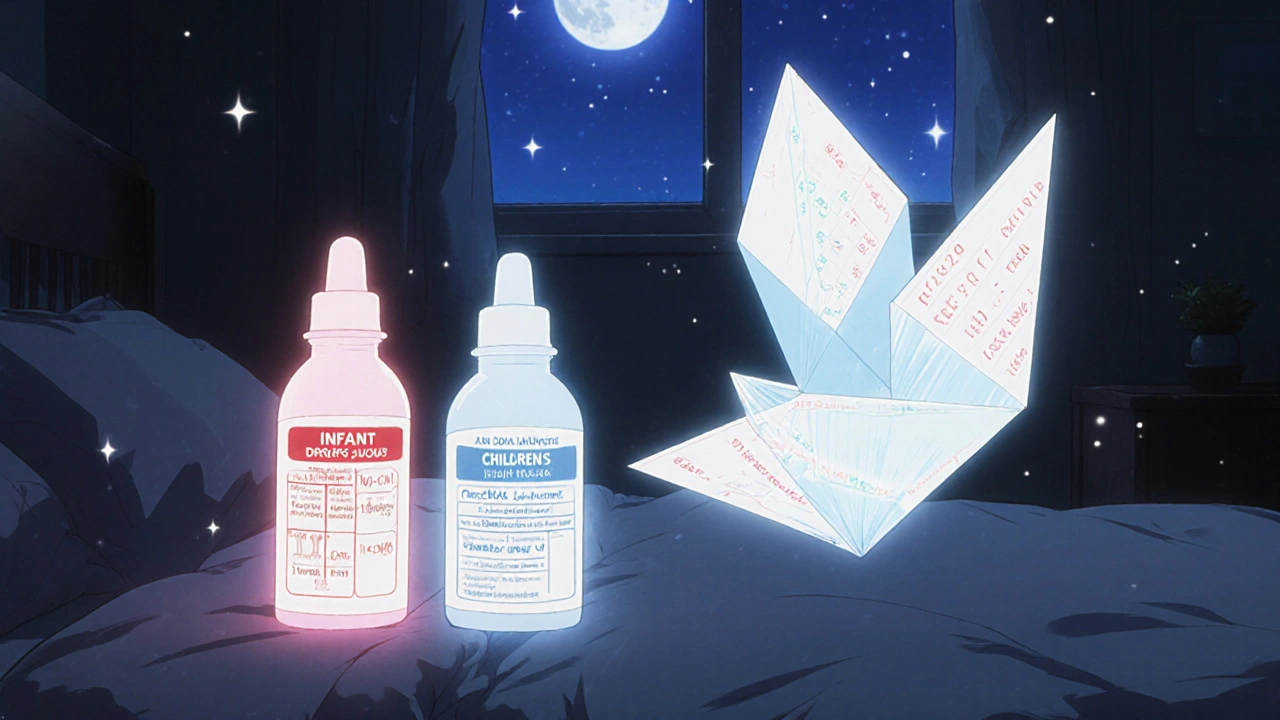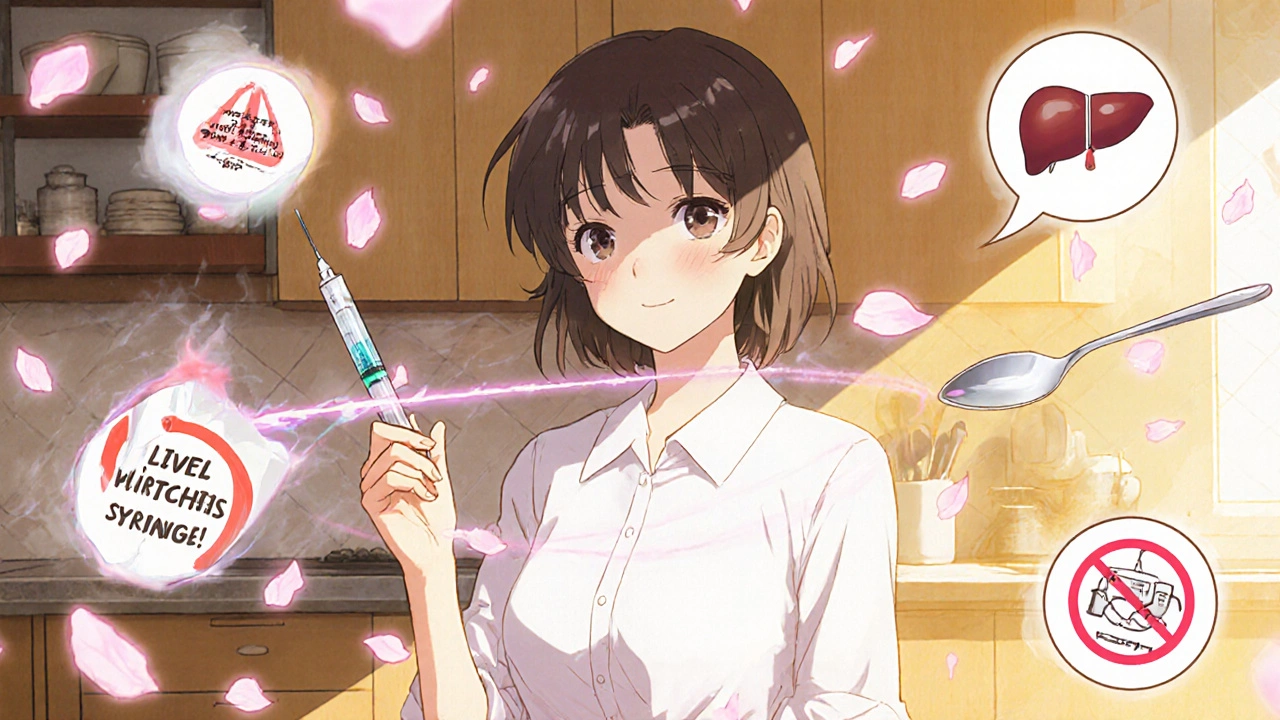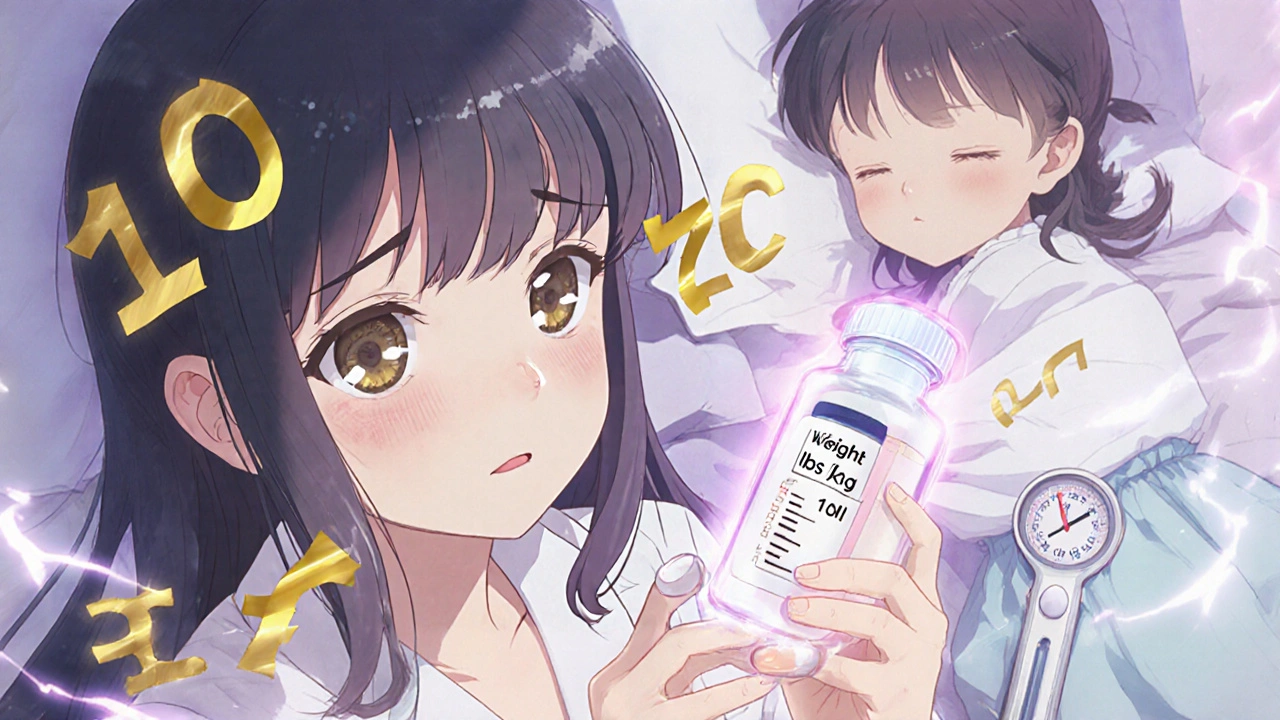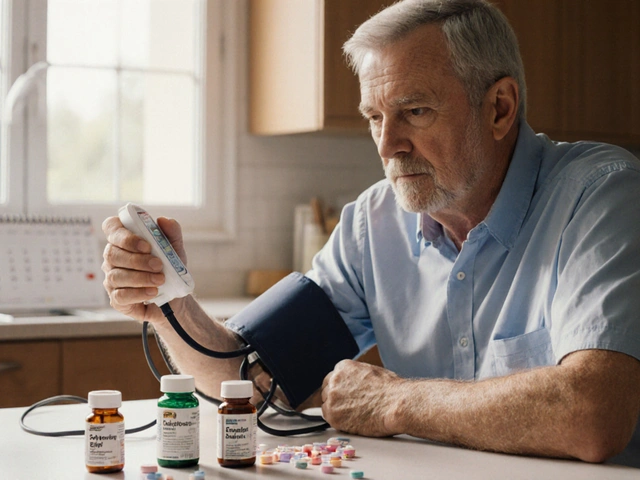Every year, over 1.4 million children in the U.S. end up in emergency rooms because of mistakes with over-the-counter (OTC) medicines. Most of these errors happen because parents don’t know how to read the label correctly. It’s not about being careless-it’s about confusing measurements, misreading age ranges, or guessing a child’s weight. The good news? The labels have changed. They’re clearer now. But you still need to know how to use them right.
Why Weight Matters More Than Age
Age is easy. You know your child’s birthday. Weight? That’s harder. But when it comes to giving medicine, weight is what actually matters.
Two kids who are both 3 years old can weigh very different amounts-one might be 28 pounds, another 42 pounds. Giving them the same dose based on age alone could mean one gets too little and the other gets too much. A 2019 study from Johns Hopkins found that using age instead of weight leads to dosing errors in 23% of cases. That’s more than 1 in 5 times.
The American Academy of Pediatrics (AAP) says this clearly: “The correct dose for your child is based on their weight, not their age.” If you don’t know your child’s weight, use age as a backup. But if you do know it-use it. Always.
What to Look for on the Label
OTC children’s medicine labels now follow strict rules set by the FDA. Here’s what you’ll see-and what it means.
- Active ingredient: This tells you what’s in the medicine. For fever or pain, it’s usually acetaminophen or ibuprofen. Never give both at the same time unless a doctor says so.
- Concentration: This is critical. Liquid acetaminophen must now be 160 mg per 5 mL. Ibuprofen is 100 mg per 5 mL. Older bottles might say “infant drops” with 80 mg per 0.8 mL. These are different. Using the wrong syringe can lead to a dangerous overdose.
- Weight-based dosing chart: Look for a table that breaks down doses by pounds or kilograms. Common weight ranges are: 12-17 lbs, 18-23 lbs, 24-35 lbs, 36-47 lbs, 48-59 lbs, 60-71 lbs, 72-95 lbs, and 96+ lbs. If your child’s weight falls between two numbers, always go with the lower dose.
- Age restrictions: You’ll see warnings like “Do not give to children under 6 months” for ibuprofen. Acetaminophen can be used as young as 2 months, but only after talking to your pediatrician.
- How often: Acetaminophen: every 4 hours, no more than 5 doses in 24 hours. Ibuprofen: every 6-8 hours, no more than 4 doses in 24 hours.
- Maximum daily dose: This is the total amount allowed in one day. For acetaminophen, it’s based on weight. For a 30-pound child, that’s usually 5 doses of 5 mL (160 mg each) = 800 mg total per day.
- Warnings: Look for “Do not use with other medicines containing acetaminophen.” Many cold and flu products have it too. Double-dosing is the #1 cause of liver damage in kids.
Never Use Kitchen Spoons
“I just used a regular teaspoon,” is one of the most common phrases heard in pediatric ERs.
A standard kitchen teaspoon holds anywhere from 4.5 mL to 7 mL-sometimes more. A dosing syringe or cup is designed to hold exactly 5 mL. That 2 mL difference? It’s 40% more medicine than intended.
St. Louis Children’s Hospital tested this. They found that 42% of medication errors came from using kitchen spoons. One parent gave their 2-year-old 15 mL instead of 5 mL because they misread “tsp” as “tbsp.” That’s three times the right dose.
Always use what comes with the medicine: a plastic syringe, a dosing cup, or a measuring spoon labeled in mL. Never trust a regular spoon-even if you think it’s “accurate.”
Acetaminophen vs. Ibuprofen: Key Differences
Both help with fever and pain. But they’re not the same.
| Feature | Acetaminophen | Ibuprofen |
|---|---|---|
| Minimum age | 2 months (with doctor approval) | 6 months |
| Dosing frequency | Every 4 hours | Every 6-8 hours |
| Max doses per day | 5 | 4 |
| Concentration (liquid) | 160 mg per 5 mL | 100 mg per 5 mL |
| Primary risk | Liver damage from overdose | Kidney stress, stomach upset |
| Special warning | “Do not combine with other medicines containing acetaminophen” | “Do not give to children under 6 months” |
Also, don’t mix them unless a doctor says so. And never give ibuprofen to a child who’s dehydrated or has vomiting or diarrhea-it can hurt their kidneys.

What About Chewables and Tablets?
Not all children’s medicine is liquid. Chewable tablets and tablets come in different strengths.
For example:
- Children’s chewable acetaminophen: 80 mg per tablet
- Children’s tablet acetaminophen: 160 mg per tablet
- Children’s ibuprofen tablet: 100 mg per tablet
If your child is supposed to get 160 mg of acetaminophen, that’s two chewables-or one regular tablet. Mix them up, and you’re giving half or double the dose.
Always check the label. The mg per tablet is printed right there. Don’t assume because it’s “children’s” that it’s the same as another brand.
Benadryl and Other Multi-Symptom Products
Benadryl (diphenhydramine) is a common allergy medicine. But it’s not safe for kids under 2 unless a doctor says so. The American Academy of Pediatrics warns against it for toddlers because of risks like drowsiness, agitation, and breathing problems.
Even worse? Many cold, flu, and allergy products contain multiple active ingredients. One bottle might have acetaminophen, an antihistamine, and a decongestant. If you give that along with a separate acetaminophen product, you’re doubling up.
Read the “Active Ingredients” section on every bottle. If you see acetaminophen, ibuprofen, or diphenhydramine more than once-don’t combine them.
What If You’re Not Sure?
It’s okay to be unsure. In fact, it’s smart to double-check.
Here’s what to do:
- Write down your child’s exact weight in pounds and kilograms.
- Find the medicine you’re using. Look at the concentration (e.g., 160 mg/5 mL).
- Match the weight to the chart on the label.
- Use the dosing device that came with the bottle.
- Check the maximum daily dose. Don’t go over it.
- Ask yourself: “Is this the only medicine with this ingredient?” If not, don’t give it.
Still unsure? Call your pediatrician. Or use a trusted dosing calculator like the one from HealthyChildren.org. It’s free, updated in 2024, and used over 17,000 times.

What’s Changing Soon?
The FDA is making more changes to make labels even safer.
- Starting in 2025, all children’s liquid medications will include “syringe units” (like 0.2 mL marks) next to mL measurements.
- By 2026, 75% of products will have QR codes that link to short video instructions on how to dose correctly.
- All acetaminophen labels now must have a bold “Liver Warning” for kids under 12.
These aren’t just paperwork changes. They’re lifesavers. A 2022 study showed that 35% of parents still misread mL measurements-even after the FDA’s 2011 standardization. The new syringe markings will help.
Final Checklist Before Giving Medicine
Before you give any OTC medicine to your child, run through this quick list:
- Do I know my child’s exact weight?
- Is this the right medicine for their symptoms?
- What’s the concentration? (Is it 160 mg/5 mL for acetaminophen?)
- Which weight range does my child fall into?
- Am I using the dosing syringe or cup that came with the bottle?
- Have I checked if another medicine I’m giving has the same active ingredient?
- Am I following the correct frequency and max daily dose?
If you answered yes to all of these, you’re doing it right. Medication safety isn’t about being perfect. It’s about being careful. One wrong dose can cause serious harm. But with the right info, you can protect your child.
Can I use age instead of weight to dose my child’s medicine?
Age can be used as a backup if you don’t know your child’s weight. But weight is always more accurate. Studies show that using age alone leads to dosing errors in 23% of cases. For example, a 3-year-old who weighs 20 pounds needs less medicine than a 3-year-old who weighs 40 pounds. Always use weight when you can.
What if my child’s weight falls between two ranges on the chart?
Always round down to the lower weight range. For example, if your child weighs 34 pounds and the chart lists 24-35 lbs and 36-47 lbs, use the dose for 24-35 lbs. Giving a higher dose than needed increases the risk of overdose, especially with acetaminophen, which can cause liver damage.
Can I give ibuprofen to a 4-month-old with a fever?
No. Ibuprofen is not approved for children under 6 months of age. For infants under 3 months with a fever, call your pediatrician immediately. For babies 2-6 months, acetaminophen may be used-but only after talking to your doctor first. Never guess.
Why do some labels say “infant drops” and others say “children’s liquid”?
Infant drops are more concentrated: 80 mg per 0.8 mL. Children’s liquid is less concentrated: 160 mg per 5 mL. They’re not interchangeable. Using the wrong syringe or measuring tool can lead to a 5x overdose. Always check the concentration on the label and use the correct dosing device that comes with the bottle.
Is it safe to give my child Tylenol and a cold medicine at the same time?
No. Most cold and flu medicines contain acetaminophen. Giving Tylenol on top of that means you’re doubling the dose. Acetaminophen overdose is the leading cause of acute liver failure in children. Always check the “Active Ingredients” list on every medicine bottle before giving anything.
How do I know if I’m giving too much medicine in a day?
For acetaminophen, the maximum is 5 doses in 24 hours, no matter the child’s weight. But the total amount (in mg) depends on weight. For a 40-pound child, that’s usually 5 doses of 5 mL (160 mg each) = 800 mg total. For a 70-pound child, it’s 5 doses of 10 mL = 1,600 mg total. Always check the label’s maximum daily dose. If you’re unsure, call your doctor.
What to Do Next
Don’t wait until your child is sick to figure this out. Take 10 minutes now:
- Write down your child’s current weight in pounds and kilograms.
- Keep a copy of the dosing chart from the medicine bottle in your phone or wallet.
- Buy a set of medical dosing syringes (5 mL and 10 mL) and keep them with your medicine.
- Save the HealthyChildren.org dosing calculator link on your phone.
Medication safety isn’t complicated. It’s just easy to overlook. But when it comes to your child’s health, overlooking something small can have big consequences. Read the label. Measure carefully. When in doubt, call your doctor. You’ve got this.








10 Comments
Nicole Ziegler
November 20, 2025 AT 15:10Just used this guide to dose my 2-year-old last night 😌✨ Turned out I was using the wrong syringe from last year’s cold med. Scary stuff. Now I’ve got a labeled one taped to the fridge. No more guessing.
Bharat Alasandi
November 22, 2025 AT 03:29Bro, this is peak public health literacy right here. 23% dosing errors from age-only? That’s not negligence-that’s systemic design failure. The FDA’s new syringe markings? Long overdue. I’ve been using the HealthyChildren.org calc since my niece was born. 10/10 recommend. No spoon. Ever. 🚫🥄
Kristi Bennardo
November 22, 2025 AT 13:47This is an outrage. The fact that parents are expected to decode pharmaceutical labeling like it’s a CIA cipher is unacceptable. The FDA has had 13 years to fix this. 1.4 million ER visits? That’s not a statistic-that’s a national failure of oversight. Someone needs to be fired. And no, ‘it’s on the label’ is not an excuse. We’re talking about children’s lives.
Shiv Karan Singh
November 23, 2025 AT 07:33u think the label is the problem? lol. its the parents. my cousin gave her kid 3x the dose because she 'trusted her gut' and the bottle looked like her last one. the label was clear. the problem is people dont read. also why is everyone so scared of tylenol? its not poison. its just chemistry. :P
Ravi boy
November 24, 2025 AT 10:19in india we just use the same syrup for all kids and hope for the best lol but this usa system is actually kinda smart. i never knew infant drops were different from kids liquid. now i get why my cousin's baby got sick last time. also no spoon always. i now use a clean eyedropper from the pharmacy. simple. works. peace out
Matthew Karrs
November 25, 2025 AT 10:39Let me guess-the FDA’s QR codes are gonna track your kid’s medication use. And the ‘syringe units’? That’s just the first step to mandatory dosing logs in the cloud. They’re building a pediatric surveillance network under the guise of safety. And you’re all just gonna click ‘agree’ while your child’s data gets sold to pharma. Wake up.
Matthew Peters
November 26, 2025 AT 19:25I just found out my 5-year-old’s acetaminophen bottle from last winter had a different concentration than the new one. I had no idea. I almost gave her a full teaspoon thinking it was the same. I’m literally shaking right now. This isn’t just helpful-it’s a救命稻草. Thank you for writing this. I’m printing it and laminating it. No joke.
Liam Strachan
November 28, 2025 AT 05:43Really appreciate this breakdown. I’m from the UK and we don’t always get the same labeling here, but the principles are universal. I’ve started keeping a little card in my wallet with my kids’ weights and the max doses. Simple, but it makes a world of difference. No need to overcomplicate it-just measure right and check twice. Cheers!
Gerald Cheruiyot
November 29, 2025 AT 05:10weight over age makes sense because bodies are not calendars. a 3 year old is not a unit. a body is a system. the label is a tool. the parent is the operator. the real danger is not the medicine but the assumption that one size fits all. we treat kids like they’re small adults with the same metabolism. they’re not. they’re evolving organisms. respect the difference. measure twice. give once.
Alyssa Torres
December 1, 2025 AT 04:58Okay I’m gonna say it-this post just saved my life. I gave my son ibuprofen at 4 months because I thought it was ‘safe enough’ and he was screaming. Turned out he had a UTI and needed antibiotics, not painkillers. I didn’t know ibuprofen wasn’t approved under 6 months. I’m crying typing this. Thank you for the checklist. I’ve printed it. I’ve pinned it. I’m never winging it again.